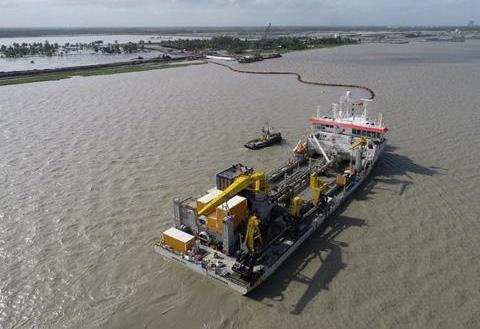
7 minute read
Port transformation
SECOND PHASE OF MAJOR PORT WORKS BEGINS
Belgian dredging giant Jan de Nul has confirmed it will begin dredging a small port in Bangladesh as part of major works that the nation says will transform it into a world-class facility
Payra Port was inaugurated in 2013, according to local media outlet TBS News, which said that since then, just 236 sea-going ships had arrived.
Once the capital dredging is completed by Jan de Nul at the end of 2023, the Rabnabad channel will be 75km long by 125m wide, with a depth of 10.5 metres. It will mean a capacity for docking of 40,000 tonnes of cargo or 3,000 containers, TBS News says.
Jan de Nul says it has ‘moved the world’ to supply Payra Port with the works needed.
“In recent months, several kilometres of pipelines, pontoons, heavy machinery and support vessels were prepared, adapted and mobilized by means of large bulk carriers, calling directly to Payra Port,” the firm says. “Because of the extremely challenging sea conditions, customized parts needed to be fabricated and existing equipment needed to be reinforced. Jan De Nul employed its logistical hubs in Singapore, Dubai and Belgium to supply the project.”
Jan de Nul, which has the contract for mainteance dredging, also said many kilometres of retaining dykes are having to be constructed, creating a reclamation basin that will be filled with sediment dredged from future berths and inner channels.
As the intention is to enable the port to receive the world’s container ships, work also needs to be done to ensure roads and bridges can cater for the increased loads.
As such, a six-lane, 6km road is being built courtesy of Spectra Engineers, along with a 1km bridge over the Andharmanik River, TBS News says.
Once this is complete, ’three foreign ships carrying containers or bulk cargos will be able to dock simultaneously at the Payra Seaport’, the outlet says.
The work has been funded by the Bangladesh Infrastructure Development Fund, the outlet quoted Prime Minister Sheikh Hasina as saying.
It also said that eight vessels had been bought for the port, including two pilot vessels, two heavy-duty speedboats, a buoy-laying vessel, a survey boat and two tugboats.

8 Jan De Nul’s
trailing suction hopper dredger Diogo Cao at work in Bangladesh
8 Jan De Nul Team
with Rear Admiral Sohail, Chairman of Payra Port, Commodore Rajib Tripura, Member Engineering and Scheme Director of the Capital and Maintenance Dredging Project and Mr. Rafiul Hasain, Member Finance and Administration of Payra Port --
Portsmouth International Port has reached an important milestone with its new solar generation system with 888 solar panels now having been switched on.
Installation began in February 2022 by specialist contractors Custom Solar, and incorporates roof-mounted solar panels across a number of buildings, a large battery and solar canopies.
“The port is owned by the people of Portsmouth, so we have an obligation to reduce the impact of our operations on the environment, whilst reaching the ambitions set out in our 20 year Masterplan,” said Jerry Clarke, pilot and senior project manager at Portsmouth International Port.
“Combined with other sustainability initiatives, it will help us achieve our ambition of reaching net-zero carbon by 2030, and becoming one of the UK’s first zero emission ports by 2050. With government support, we really can make a clean maritime industry a reality”.
Renewable energy
The solar panels mounted on rooftops around the port are now generating 400kWp of renewable energy that can be used to reduce consumption at the port, or can be exported back to the grid.
This is just a third of the total number of solar panels installed at the port over the past year. Once they are all switched on, the the 1.2mW peak system with 2,660 panels will contribute around 35% of the port’s energy needs. This will be a big step forward for Portsmouth International Port’s ambition to reach net-zero by 2030.
The system will also include a 1.5mWh battery, which is enough power to run a typical home for four months. It will capture green power that can then be used at the port at another time, such as to power lights at night.
PORT REACHES SOLAR POWER MILESTONE
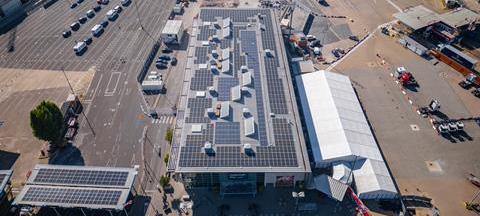
8 The solar panels mounted on rooftops
around the port are generating 400kWp of renewable energy
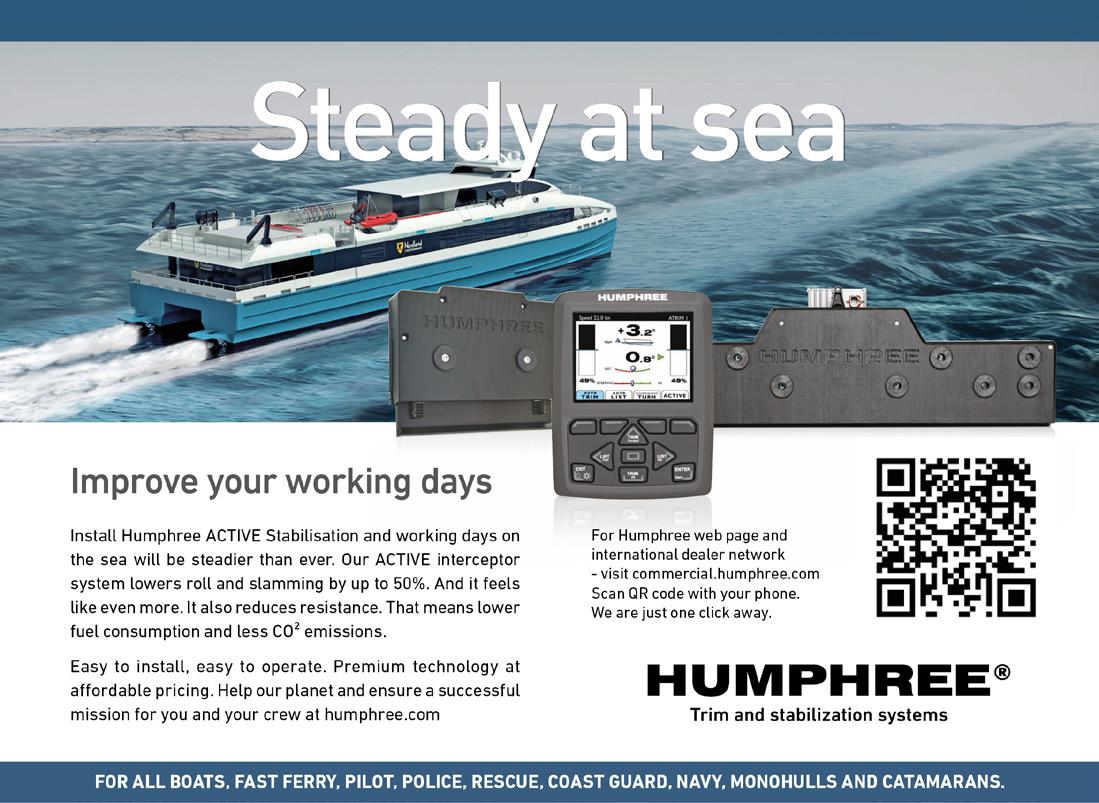
64 WINCHES ORDERED FOR LONGEST IMMERSED TUNNEL
The Fehmarnbelt immersed tunnel connecting Denmark and Germany needs 64 winches to position subsea equipment - for which DMT Marine Equipment is happy to oblige
The 40m deep, 18km long tunnel will contain a total of five tubes - two for rail, two for roads and one for service.
A total of 89 elements will be connected together to make up the length of the tunnel, 79 of these weighing 73,500 tonnes each, the remaining 10 weighing 21,000 tonnes each.
Each will have been cast incrementally in concrete segments over a skeleton of reinforced steel in large casting moulds in a purpose-built factory on the Danish side. Once set, the elements are pushed out to a dry dock one by one and sealed at both ends with a bulkhead before being towed by tug and lowered on to the seabed.
With millimetre precision, they are fitted together, water is pumped out and a partial vacuum ensures they are locked together.
Click here to read article on Maritime Journal online
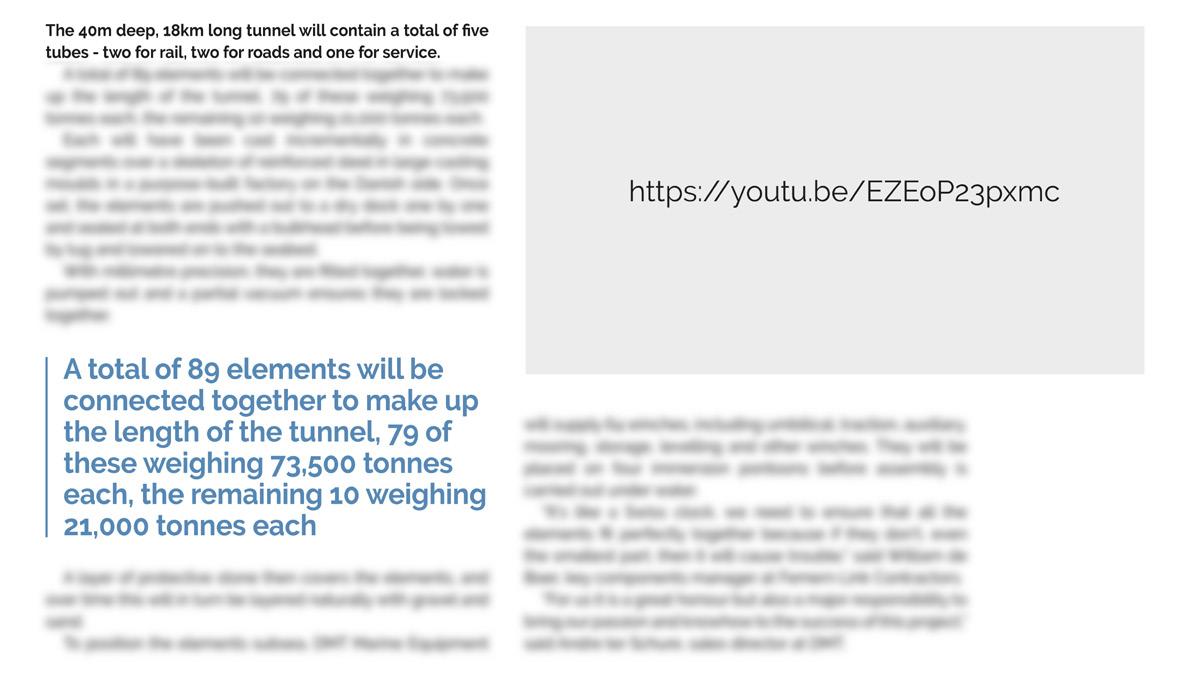
A layer of protective stone then covers the elements, and over time this will in turn be layered naturally with gravel and sand.
To position the elements subsea, DMT Marine Equipment
https://youtu.be/EZEoP23pxmc
will supply 64 winches, including umbilical, traction, auxiliary, mooring, storage, levelling and other winches. They will be placed on four immersion pontoons before assembly is carried out under water.
“It’s like a Swiss clock, we need to ensure that all the elements fit perfectly together because if they don’t, even the smallest part, then it will cause trouble,” said William de Boer, key components manager at Femern Link Contractors.
“For us it is a great honour but also a major responsibility to bring our passion and knowhow to the success of this project,” said Andre ter Schure, sales director at DMT.
Major flood defence work reduces risk to 0.5%
The UK government says a £12 million (€13.8 million) tidal defence scheme to protect 1,400 homes from flooding has been completed.
The works, which have been completed at the small port town of Exmouth in Devon, are just one project out of a total £5.2 billion (€6 billion) that has been earmarked for flood and coastal defences across England.
The Exmouth scheme was actually in three parts and was first conceived in 2015, when it was decided protection was needed for the town in southwest England because it is prone to tidal flooding. It was identified as part of a flood risk management strategy for the whole of the Exe Estuary.
Team Van Oord, a joint venture between civil engineers Royal HaskoningDHV and Kier, designed and built the scheme, which included adding 27 new flood gates along
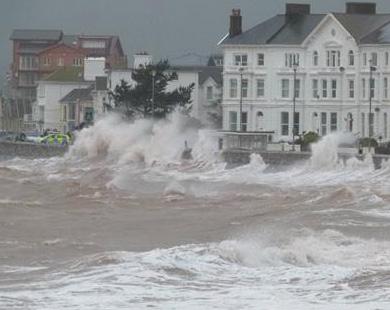
8 Flood defence works were completed in
Devon, southwest England, as part of a €6 billion package for flood and defence work across England as a whole
the sea front and improved drainage for water to be able to get back out to sea. New set-back defences were added along the land side of the Esplanade so that if flooding does occur, the water will not flow down nearby roads.
Flood embankments and walls have also been raised on the estuary side of Exmouth, as well as around what is known as the ‘gut’ at Camperdown Creek.
In 2016, the Environment Agency decided that there was a 4% flood risk in any year at Exmouth. Now, it says, the risk has been reduced to 0.5% and no further defence improvements should be required until 2045.
“Exmouth’s new flood defences and further schemes across the country will be more important than ever to build a more resilient nation against greater weather extremes,” said UK Floods Minister Trudy Harrison. ”I hope Exmouth’s added protection will bring much needed peace of mind to homeowners and give businesses the confidence to invest and grow.”









